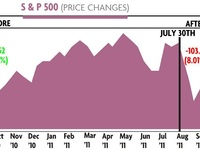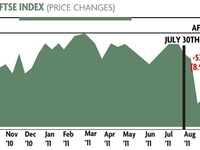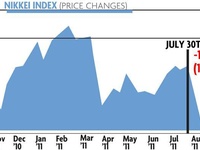Rittereiser also noted that the sovereign debt difficulties of a nation may not be reflected in the fiscal health of companies within that country. But if half of Europe’s banks need to be rescued, every investor will suffer, Golub said.
THE PAST YEAR
Although HMC’s gains on the year once again put the endowment in the vicinity of its $36.9 billion peak, Harvard underperformed the S&P 500 stock index. Analysts, however, say the endowment should be judged by a different standard.
Because HMC’s portfolio is diversified far beyond U.S. equities, which the S&P tracks, its results will naturally be different from the index, Rittereiser said.
“It is not an appropriate benchmark,” said Rittereiser of the S&P 500. “It is kind of like comparing apples to oranges.”
HMC sets its own policy portfolio benchmark, a custom metric that Rittereiser said is the best way to measure endowment performance because it reflect’s HMC’s unique risk appetite.
“I would be willing to say that it is highly likely that the risk-adjusted returns [of HMC] would be better than the S&P,” she said.
Every one of HMC’s asset classes outperformed its policy portfolio benchmark, except for private and public equities. Historically, private equity has been an enormously successful investment for the University.
Harvard and other universities were among the earliest investors in private equity, though the asset class has not performed as well in recent years due to greater competition in the industry.
Though many of Harvard’s closest peers have yet to release their endowment reports for 2011, it appears so far that Harvard has achieved above average returns. The University of Pennsylvania posted an 18.6 percent return for the last year, while Cornell’s endowment rose 17.2 percent.
But Stanford’s endowment, which released results earlier this week, rose 22.4 percent, a full percentage better than Harvard.
But like Mendillo, Stanford’s investment chief sees a bumpy road ahead.
“We remain concerned about the uncertain macroeconomic climate and its impact on global financial markets,” said John F. Powers, CEO of the Stanford Management Company, in a press release.
While Harvard appears ahead of the pack, Golub warns that the University cannot expect such exceptionally high returns on a regular basis.
“If you told me an endowment manager made 21 percent or more every year, I would say you’ve found Bernie Madoff,” Golub said.
Still, many remain confident that HMC will be able to weather upcoming financial storms.
“[Mendillo] is doing an outstanding job of building confidence in the alumni community that HMC is being a successful and responsible steward,” Golub said.
—Staff writer Gautam S. Kumar can be reached at gkumar@college.harvard.edu.
—Staff writer Zoe A. Y. Weinberg can be reached at zoe.weinberg@college.edu











